La consideración más importante en el momento actual, tiene relación con el retlujo alcalino contaminado con jugo duodenal el cual es también causante directo de las complicaciones esofágicas. En estos casos, es obligatorio complementar la cirugía antirretlujo con procedimientos de desviación duodenal para obtener la curación del paciente y evitar el alto índice de recidivas.
Los procedimientos de desviación duodenal utilizados han sido el asa de Henley (130) y la derivación en Y de Roux (131); pero la mortalidad en estos casos fue del 2.4% y la morbilidad del 11%. El doctor Tom DeMeester (132, 133) propuso una desviación duodenal conservando el antro gástrico y el píloro para evitar el alto índice de morbimortalidad de las otras derivaciones; la denominó “switch duodenal” y consite en cerrar el asa distal de duodeno, 4 a 6 cm del píloro y anastomosar el asa de yeyuno terminoterminal con el muñón proximal de duodeno (Fig. 16). Los resultados son muy alentadores.
Durante 23 años practicamos la calibración cardial y gastropexia posterior como único procedimiento, según la técnica de Larraín (127), en 752 pacientes adultos con ROEP y en quienes estaba indicada la corrección quirúrgica (Tabla 13).
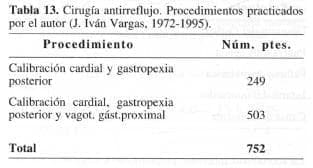
A partir de 1981 por intlujo de los trabajos de Csendes (134), DeMeester (135) y Boesby (136), complementamos todos los procedimientos antirretlujo con la vagotomía gástrica proximal. A fines de 1993, regresamos de nuevo a la calibración cardial y gastropexia posterior sin vagotomía, movidos por las investigaciones de Hirschowitz (50), quien demuestra la inexistencia de hipersecreción ácida del estómago en los pacientes con RGE, y afirma que el peligro lo constituye la contaminación alcalina gástrica que refluye.
La única variante en esta nueva etapa, fue la de despejar el cardias según lo preconizado por el doctor Alvaro Caro (137) para facilitar la calibración cardial con precisión.
Al control postoperatorio del primer mes sólo dejaron de asistir 2 pacientes. El 90% de los casos exhibía buenos resultados; 6.6% no referían ningún síntoma de reflujo pero se quejaban de plenitud y flatulencia. Y el 2.1% se consideraron casos insatisfactorios clínicamente. Además, a éstos se debe añadir 7 muertes en el postoperatorio. A 1 año logramos revisar 654 pacientes. Los buenos resultados clínicos se mantenían y los casos de recurrencia del RGE fueron el 1.4% (Tabla 14).
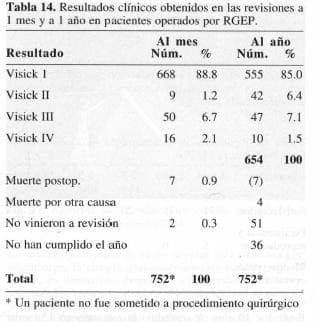
Observamos cómo a partir del 2° año y hasta el 5°, ocurre la mayor incidencia de recurrencia y luego a medida que pasan los años se va estabilizando la mejoría (Tabla 15). Este es también el período de más alta recurrencia en otras series (138).
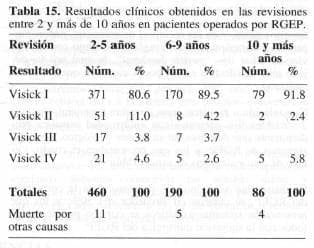
La revisión de pacientes a varios años es difícil en nuestro medio en el que las personas tienen tendencia a buscar al especialista cuando no encuentran mejoría en consultas más económicas; otros porque viven en sitios distantes e igualmente, porque la búsqueda de las historias clínicas de nuestro Hospital Universitario y del Seguro Social, fue imposible.
Sinembargo, observamos que a menor número de pacientes controlados, los buenos resultados eran muy satisfactorios.
En estenosis esofágica no fue extraño encontrar que entre I y 10 años el índice de reproducción fue del 32%, cifra similar a la presentada por Csendes (5) en sus casos dc estenosis (Tabla 16).
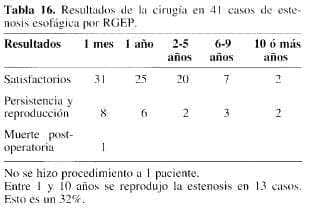
No se hizo procedimiento a I paciente.
Entre I y 10 años se reprodujo la estenosis en 13 casos.
Esto es un 32%.
Anteriormente no sabíamos que una gran proporclon de las complicaciones esofágicas del RGEP, se debía a un reflujo alcalino con contaminación duodenal y de allí los malos resultados. Desde hace 2 años, estamos buscando identificar los casos con reflujo alcalino y con tal propósito ya adquirimos el equipo para monitoría del pH.
En estos casos, y en las recidi vas de estenosis, hemos empezado a complementar la cirugía antirreflujo con la desviación biliar tipo “switch duodenal”, la cual nos ha dejado muy satisfechos en los pocos casos en que la hemos realizado.
Con relación a nuestros casos de asma bronquial, tuvimos 2 variables: los pacientes con enfermedad asmática predominante que desconocían su origen etiológico, pero con síntomas de RGEP, y los que presentaban el cuadro clínico de éste y síntomas de asma (Tabla 17).
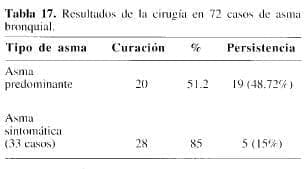
Es interesante ver cómo los primeros, con la corrección del RGEP, se curaron en alrededor del 50%; y los que presentaban síntomas asmáticos se curaron prácticamentetodos con la supresión quirúrgica del RGEP.
Estas citas están acordes con los informes de que todo paciente asmático con síntomas de RGE, se mejora en el 50% de los casos, independientemente de su origen etiológico y de los síntomas asmáticos producidos por el RGE (69,71).
Las complicaciones intraoperatorias o iatrogénicas se presentaron en 21 pacientes. que corresponden al 2.8’k. De ellas 2 perforaciones del esófago originaron el fallecimiento de los enfermos. De los 21 casos. 14 fueron desgarrosdel bazo y desgarros del cardias.
Nuestra mortalidad fue del 0.9′,/r (Tabla 18). Los casos de pancreatitis ocurrieron por acompañar el procedimiento antirreflujo con esfinteroplastia tranduodenal en pacientes con coledocolitiasis residual.
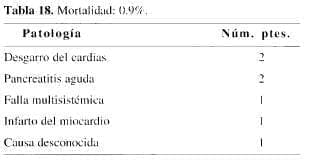
La mortalidad inherente propiamente a la cirugía antirreflujocorrespondió a los 2 casos de desgarro del cardias.
Cirugía Laparoscópica
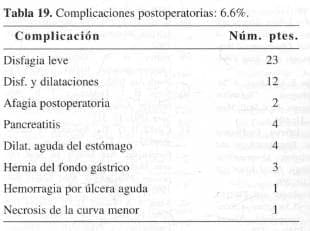 La morbilidad en nuestra serie fue de 6.6’1c. correspondiente en su mayor parte a disfagia. en 35 pacientes que fue transitoria y leve en 23 casos. y requirió de una a tres sesiones de dilatación en 12 casos (Tabla 19).
La morbilidad en nuestra serie fue de 6.6’1c. correspondiente en su mayor parte a disfagia. en 35 pacientes que fue transitoria y leve en 23 casos. y requirió de una a tres sesiones de dilatación en 12 casos (Tabla 19).
Dos casos de afagia se revisaron en cirugía sin encontrar causa, pero mejoraron; sinembargo. 1 de los pacientes presentadisfagias ocasionales. Por pancreatitis fallecieron 2. Una de las hernias del fondo gástrico requirió reintervención precoz; y el caso de necrosis de la curva menor post- VGP. se presentó tardíamente y se reintervino 2 meses después.
De nuestros pacientes que recidivaron nos corespondió intervenir a 3. y se incluyeron en la casuística total 28 recurreneias de RGEP de otros colegas. que reintervinimos con buenos resultados.
También estamos intentando incursionar en la cirugía videoendoscópica para tratamiento del RGEP.
Este procedimjento para tratamiento del ROEP se inició en el mundo a partir de 1991 (139).
En el año pasado realizamos la calibración carillal por vía laparoscópica en 14 pacientes a quienes escogimos, previo estudio con los siguientes exámenes: gamagrafía esofágica, manometría esofágica, radiografía y endoscopia.
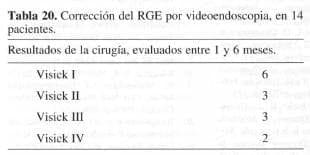 Los primeros 6 casos los hicimos con la asesoría del Profesor Augusto Larraín y los 8 restantes por p~te del equipo de cirujanos laparoscópicos de la Clínica Medellín (Tabla 20).
Los primeros 6 casos los hicimos con la asesoría del Profesor Augusto Larraín y los 8 restantes por p~te del equipo de cirujanos laparoscópicos de la Clínica Medellín (Tabla 20).
Los resultados se asemejan a los de algunas de las series publicadas (140-142). En muchas se exhiben excelentes resultados y en otras se anotan altos índices de morbimortaljdad (143).
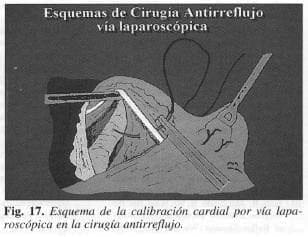 La tendencia mundial es la de adoptar esta metodología; sinembargo, la cirugía anatomofisiológica para corregir el ROEP, es demasiado exigente y el procedimiento videoendoscópico repara la abertura dilatada del cardias pero no· se cumple con firmeza el anclaje de la unión esofagogástrica al ligamento arcuato medio; sólo permite hacerlo a los haces musculares del pilar diafragmático derecho y esto deja mucho qué desear (Fig. 17).
La tendencia mundial es la de adoptar esta metodología; sinembargo, la cirugía anatomofisiológica para corregir el ROEP, es demasiado exigente y el procedimiento videoendoscópico repara la abertura dilatada del cardias pero no· se cumple con firmeza el anclaje de la unión esofagogástrica al ligamento arcuato medio; sólo permite hacerlo a los haces musculares del pilar diafragmático derecho y esto deja mucho qué desear (Fig. 17).
Esta evolución, así como la de las demás series publicadas, hasta ahora se inicia. Debemos esperar el dictamen de la experienoia y sus resultados en un mínimo de 2 años.
Vemos muy difícil que por medio del procedimiento videoendoscópico, podamos tratar correctamente los casos de ROEP con trastorno motor severo del esófago, así como sus complicaciones esofágicas, y los pacientes con reflujo alcalino contaminado con bilis.
Continuaremos sí con esta práctica, pero con una escongencia estricta de los pacientes con reflujos sintomáticos de contenido ácido o de esofagitis I y 11, Y como alternativa frente a tratamientos médicos a largo plazo.
De todos modos, bien sea con los métodos quirúrgicos a cielo abierto o con esta nueva tecnología endoscópica, los cirujanos debemos conservar las normas éticas y científicas del más alto nivel para elegir el procedimiento preciso en cada paciente, a fin de no propiciar, eventualmente, el ocaso de la cirugía antirreflujo.
Referencias
1. Vélez A: Del Big Bang al Homo Sapiens. Editorial Universidad de Antioquia. Medellín 1994; p. 63
2. Breasted J H: The Edwin Smith Surgical Papyrus, University of Chicago Press. Chicago 1930; p. 312
3. Avenzoar (1162), quoted by Mayor R A. In: A History of Medicine. Apringfield, lIT., Charles C. Thomas, 1954; p. 252
4. Tavengot: Observations sur Maladie Rare de L’Oesophage. J Med Chir Pharm 1786; 67: 254
5. Csendes A: Retlujo Gastroesofágieo. Conf XX Congr Soc Col Cir, Bogotá, agt 18, 1994
6. Winkelstein A: Peptic Esophagitis (A New Clinieal Entily) JAMA 1935; 104: 906
7. Harrington S W, Kirklin B R: Clinieal and Radiological Manifestations and Surgical Treatment of Diaphragmatic Hernia with a Review of 13 cases. Radiology 1938;30: 147
8. Allison P R: Retlux Esophagitis, Sliding Hernia and the Anatomy of Repair. Surg Gynecol Obstet 1951; 92: 419
9. Dent J: Oesophagitis is Just the Tip of the Iceberg of Reflux Disease. In: Coneepts and Controversies in Esophageal Reflux Disease. Special Report From the XIII Internal Congr Gastroenterol. Roma1988; p. 1
10. Sivri B, McCallum R W: What has the Surgeon to Know about Pathophysiology of Retlux Disease. World J Surg 1992; 16: 294
11. Deschner W K, Stanley B B: traesophageal Manifestations Gastroesophageal Retlux Disease. Gastroenterol 1989; 84: 1
12. Hill L D: Mediam Arcuate Repair of Hiatus Hernia and Gastroesophageal Reflux. In: Varco, R L, Delaney J P: Controversy in Surgery. Philadelphia, W.B. Saunders Co., 1976; p. 513
13. Nohel O T, Fores M F, Castell D O: Symtomatie Gastroesophageal Retlux: Incidence and Precipitating Factors. Dig Dis 1976; 21: 953
14. Ahtaridis G, Snape W J Cohen S: Clinical and Manometric Finding Peptic Stritures of the Esophagns. Dig Dis Sci 1979; 24: 858
15. Howard P J, Heading R C: Epidemiology of Gastro Esophageal Retlux Discase.World J Surg 1992; 16: 288
16. Matthes M: Diagnóstico Diferencial de las Enfermedades Internas. 4a. Ed. (Traduc 7a. Ed. Alemana Barcelona, Edit Labor S.A., 1937; p. 592
17. Randolph J G, Lilly J R, Anderson K D: Surgical Treatmemt 01′ Gastroesophageal Reflux in Infants. Ann Surg 1974; 180: 479 Exof Am J
18. Bassey O O, Eyo E E, Akinhanmi G A: Incidence of Hiatus Hernia and Gastroesophageal Rellux in 1030 Prospetive Barium Meal Examinations in Adult Negerians. Thorax 1977; 32: 356
19. Chene P, Lortat Jacoh J L, Robert F, Mailland J N: Etiopathogenie do. Retlux Gastroesophagien. Arch Mal App Dig 1955; 44 (Suppl): 20
20. Halloway R H, Dodds W J: Pathogenesis. In: Jamieson G G: Surgery of Esophagus. Edinburgh, Churchil Livingstone, 1988; pp. 173
21. Anderson H N: The Lower Esophageal Intrinsec Sphincter and Mecanism of Retlux: Experimental Observations Supporting a New Concept. Ano. Surg 1967;166: 102
22. Lyons W S: Hellis F H, Olsen A M: The gastroesophageal “Sphincter Mechanism”. A Review. Proc Slaff Meet Mayo Clinic 1956; 31: 605
23. Wolf B S: The Inferior Esophageal Sphincler Anatomic. Roentgenologic and Manometric Correlation, Contraindications and Terminology. Am J Roentg R Th N Med 1970; 110: 260
24. Lerche N: The Esophagus and Pharynx in Action; a Study of Structure in Relation lO Funetion. Springfield, Illinois, Charles C. Thomas 1950; p. 222
25. Fyke F F, Code C F, Scheleger .1 F: The Gastroesophageal Sphincter. In: Healty Human Beings. Gastroenterology 1956; 86: 135
26. Laimer F: Beitrag Zur Anatomie des Oesophagus. Med Jahrbucher, 1883; p. 333
27. Nauta J: The Closing Mechanism between the Esophagus and the Stomach. Gastroenterology 1956; 86: 219
28. Waukling W .1, Warrian W G, Lind J F: The Gastroesophageal Sphincter 111Hiatus Hernia. Can J Surg 1965; 8: 61
29. Pope C E 11: A Dynamic Test of Sphineter Strength: its Applieation to the Lower Esophageal Sphincter. Gastroenterology 1967; 52: 779
30. Winans C S, Harris L D: Quantitaion lo Lower Esophageal Sphincter Competence, Gastroenterology 1967; 52: 773
31, Haddad J K: Relation of Gastroesophageal Retlux lo Yield Sphincter Pressures. Gastroenterology 1970; 58: 175
32. DeMeester T R, Stein H J: Gastroesophageal Retlux Disease. In: Moody L C. Carey R C, Joces K S et al (ed): Surgical Treatment of Digestive Disease. 2a Ed, Chicago, Edit Tors. Year Book Medieal Puhlishers, 1989; p. 65
33. DeMeester T R: Role of Valve Function. In: Gastroesophageal Reflux Esophagitis- Not Simply an Acid Disease, Highlights of an International Symposium. Philadelphia, Med Inform Serv, 1990; p, 11
34. Hill L D, Kraemer S J M et al: Laparoscopic Hill Repair. Contemp Surg 1994; 44: 13
35. Ingelfinger F J: Esophageal Motility. Physiol Rev 1958; 38: 533
36. Pope C E 11: Pathophysiology and Diagnosis of Retlux Esophagitis. Gaslroenterology 1976; 70: 445
37. Mercer C D, Hill L D: Anatomy 01′ the Esophagus. In: Hill L D: The Esophagus. Philadelphia, W B. Saunders Comp, 1988: pp. 18-20
38. Botha G S M: The Gastroesophageal .Iuntion. Boslon, Litle Brown and Co .. 1962
39. Jeffrey H P, DeMeester T R: Gastroesophageal Rellux. Surg Clin North Am 1993; 73: 1119
40. Stein H J, DeMeester T R: Who Bencfits Antirrctlux Surgery”‘. World .l. Surg 1992; 16: 313
41. Castcll D O: Thc Spectrum 01′ Gaslroesophageal Reflux Disease, Retlux Esophagitis: Not Simply an Acid Disease. Highlighls of an Intcrnational Symposium. Philadelphia, Med Inform Serv 1990; pp. 5
42. Khan A A, Castcll D O: Clinical Features. In: Jalllieson G G: Surgery 01′ the Esophagus. Edinhurgh Churchill Livingstone. 1988; p. 167
43. Kearney J R: Gastroesophageal Reflux. Phis Assist 1992; 13 (6): 15
44. Dent J: Normal Esophagcal Function. In: Jalllieson. G. G: Surgcry of the Esophagus. Edinhllrgh. Churchill Livingtone, 1988; p. 41
45. Stanciu C. Bennetl J R: Esophageal Acid Clearance, One Factor in the Production of Reflllx Esophagitis. Gut 1974; 15: 852
46. Larraín A: Hernias del Hiato Esofágico del Diafragma. Cuad Chil Cirug 1976; 20: 91
47, Fennerty M B. Salllpliner R E: Gastroesophageal Retlux. Hosp Med 1993; Apr; 24
48. Orlando R C: Esophageal Mucosal Protection, Retlux Esophagilis: not Simpli and Acid Disease, Highlights of ‘In International Symposium. Philadelphia Med Inform Serev 1990: p. 6
49. Klingman R R, Stein H J. DeMeester T R: Management of Gastrocsophageal Reflux. Curr Year Book Med Puhlishers. Chicago, 1989: p. 259
50. Hirschowiv B 1: A Critical Analisis, eith Appropriate Control s 01′ Gastric Acid and Pepsin Secretion in Clinical Esophagitis. Gastroenterology 1991: 101: 1149
51. Stein H J, Barlow A P, DcMccstcr T R et al: Complications of Gastroesophageal Reflux Disease: Role of the Lowcr Esophageal Sphincter. Esophageal Aeid and AcidAlkaline Exposure, ami Duodenogaslric Rellux. Ann SlIrg 1992: 216: 35
52. Stein H J, Fcussner H, Kaucr W et al: Alkaline Gastroesophageal Retlux: Assessment by Amhlllatory Esophageal Aspiration and pH Monitoring. Am J Surg 1994: 167: 16.-\
53. LujanMolllpean J A. Rohles Campos R, Parrillaparicio P el al: Duodenogastric Retlux in Patients with Biliary Lithiasis Before an Afler Cholecysteetomy. Surg Gynecol Ohstet 1993: 176: I 16
54. Champion G. Richter J E. Vac!i M F el al: Duodenogaslro- esophageal Rellux Relalionship lo pH and Importance in Barrett Esophagus. Gastroenterology IlJlJ4: 107: 747
55. Johnson L F. Harman J W: Experimental Esophagitis in a Rabbit Model. J Clin Gastroenterol IlJ~6: ~ (Suppl): 26
56. Trousseau A: Gastrile Chronique. Clin Med. L’ Hotel-Dieu de Paris. 7a Ed. Tome Troisiene. Paris. Libr J.B. Bailliere et Pils. 1~X5: p. 74
57. Chernoviz P L N: Diccionario de Medicina Popular y Ciencias Accesorias. 2a Ed. T. Primero. Paris. A. Roger y F. Chernoviz. Libr Edil. 1~lJ5
58. AlvarCl. W C: Nervousness Indigestion and Pain. 5a Ed. N Y. Paul B. Hoeber Inc. IlJ43: pp. 373. 3lJI. 40lJ 5lJ. Bockus H L: Gaslroenterology. 2a Ed Vol l. Philadelphia. W. B. Saunders Comp. 1%3: p. 36lJ
60. Osler W: The Principies and Practice 01′ Medicine. New York. Appleton 1~lJ2
61. Ruseel C O H: Simptoms 01′ Esophageal Disease. In: Hill L D: The Esophagus. Philadelphia. W B. Saumlers Co. IlJXX: p. 34
62. Cheadle W G. Vitale G C. Sadek S A el al: Computeri/ed Ambulatory Esophageal pH Monitoring in 50 Asymptomatic Volunteer Subjets. Am J Surg IlJX~: 155:503
63. Tylgal G N J. Hamcctcman W: The Neoplastic Potential 01′ Columnar-Lined (Barre!’s) Esophagus. World Surg 1992: 16: 30~ M. Crump W J: Rcllux Esophagitis. Diagnosis Pathophysiology and Managcmcnt. PrimCare 19~~: 15: 13
65. Urschel H e. Paulson D L: Gastroesophageal Rellux and Hiatal Hernia. J Thor Cardiovasc 1967: 53: 21
66. Skinner D B. DeMeestcr T R: Gaslroesophageal Reflux. in Current Problems in Surgery. Chicago. Year Book Med Publis Inc .. 1976: p. ~
67. Ing A J. Ngu M e. Breslin A B: Chronic Persistenl Cough and Clearance 01′ Esophageal Acid. Chest 1992: 102: 166~
68. Irwin R S. Curley F J. Bennett F M: Chronic Cough Due lo Gastroesophagcal Rellux. Clinica!. Diagnostic. Ami Pathoncgetic Aspects. Chest 1993: 104: 1511
69. Larraín A. Carrasco E. Galleguillos F el al: Medical and Surgical Treatmenl 01′ Nonallergic ASlhma Associaled wilh Gastroesophageal Rellux. Chesl IlJ91: 99: 1330
70. Sontag S. O’Connell R N. Greenlee H el al: Is Gastroesophagcal Retlux a Factor in some ASlhamatics’) Am Gastroenterol 19~7: 33: ~n Sontag S J. Schnell T Prevalence 01′ Esophagilis in 1992: 33: ~n
71. Larraín A. Lira E. Otero M: Laringitis Posterior. Su Asociación con Retlujo Gastroesofágico. Cuad Chil Cir 1977: 21: 241 71. G et al: Asthmaties.
73. Vargas J 1: Tratamiento Quirúrgico de las Complicaciones Broncopulmonares. Y Sínlomas Esofágicos de RellujoGastroesofágico Patológico. Trib Méd 1977: 56 (7): 25
74. Ward P H. Hanson D G: Retlux as anEtiologieal Factor 01′ Carcinoma 01′ theLaryngopharynx. Laringosgope 19~~: 9~:1195
75. Gabriel C E. Jones D G: The Importance 01′ Chronic Laryngitis. J Laryngol Otol 1%0: 74: 349
76. Morrison M D: Is Chronic Gastroesophageal Retlux a Causative Factor in Glottic Carcinoma’) Otolaryngol Head Neek Surg 1988: 99: 370
77. Slein H J. DeMeester T R: Indicalions Technique and Clinical Use 01′ Ambulatory 24 Hour Esophageal Motilily Monitoring in Surgical Practice. Ann Surg 1993: 217: 128
78. Ament M E. Castell D O. DeMeester T R. Devose M: Treatment 01′ Gastroesophageal Retlux. Patient Care 1990 Jul: 25
79. Singh S. Richter J E. Hewson E G el al: The Contrihution 01′ Gastroesophageal Rdlux to Chest Pain in Palients With Coronary Artery Disease. Ann Inter Med 1992: 117: 824
80. Herbst J J. Bock L F. Bray D F: Gaslroesophageal Retlux. In: The “Near Miss” Sudden Infant Death Syndrome. Pediatrics 1988: 92: n
81. Annstrong F W. McMillan D G. Simmon J B: Swallow Syncope. Can Med Assoc J 19~5: 132: 12~1
82. Wright R A. Miller S A, Corsello B F: Acid Induccd Esophagobronchialcardiac Rdlcxes in Humans. Gastroenterology 1990: 99: 71
83. Stiegmann G R. Pearlman N W, Teter A: Upper Aerodigestive Manifestations 01′ Gastroesophageal Reflux. Gastroenterology 1987: 92: (Abst) 1654
84. Vargas J 1: Retlujo Gastroesofágico Patológico. En: Olarte F, Arislizábal H. Botero M. Restrepo J: Cirugía. la Ed. Medellín. Edit U. de A.. 1983, Tomo 11. p. 80
85. DeCarvalho M M: Chirurgie du Syndromc Hiatocsophagicn. Arch Mal App Digest 1951; 40: 280
86. Monges H, Monges A. Gambarelli J: Physio Patologic du Retlux Oesophagien. Arch Mal App Dig 1955; 44 (Suppl): 1 ~7. Atkinson M. Edwards O A W et al: TheEsophagogastric Sphincter in Hialus Hernia.Lancet 1957; 2: 1138
88. Bernstein L M. Baker L A: Clinical Test 1’01’ Esophagitis. Gastroentcrology 1961:34: 1
89. Johnson L F, DeMeester T R: Twenty Four Hour pH Monitoring 01′ the Distal Esophagus: A Quantitative Measure 01′ Gastroesophageal Reflux. Am Gastroenterol 1974; 62: 325
90. Fisher R S. Malmud L S et al: Gastrocsophageal Scintiscanning to Dctect and Quantitate G. E. Retlux. Gastroenterology 1976; 70: 301
91. Bombeck C T, Vaz O et al: Computarized Axial Manometry 01′ the Esophagus. Ann Surg 1987; 206: 465
92. Vargas J 1: Corrección Quirúrgica del Retlujo Gastroesofágico Patológico. (Evaluación de 70 casos). Anlioq Méd 1975; 25: 467
93. Linsman J F: Gastroesophageal Retlux Elieet While Drinking Water (Water Siphonage Test). Am J Roent Rad Thorac Nucl Med 1965; 94: 325
94. Crummy A B: The Water Test in Evalualion 01′ Gastroesophageal Retlux. Radiology 1966; 87: 501
95. Behar J: Retlux Esophagitis. Arch Intern Med 1976: 136: 560
96. Behar J: Evaluation 01′ Esophageal Tests in the Diagnosis 01′ Rdlux Esophagitis. Gastroenterology 1976; 71: 9
97. Malmud L S. Fisher R S: Radionuclide Studies 01′ Esophageal Transit and Gastroesophageal Retlux. Semin Nucl Med 19~2; 12: 104
98. González P: Técnica e Interprctación del Análisis Gamagráfico del Rellujo Gastroesofágico. Cumunic Per. Santiago de Chile. Marzo 1988
99. Datz F: Teaching Editorial: The Role 01′ Radinuclide Studies in Esophageal Disease. J Nucl Med 19~9; 25: 1040
100.Touya J l. Bekennan C, Mena J G: Protocolo e Indicaciones de los Procedimientos de Diagnóstico Basados en Imágenes de Gama Emisores. IX Congreso Asociac Latinoam Soc BiolMed Nucl (ALASIMN). Montevideo. Uruguay. Dic 9 19~4
101. Taillefer R, Beanchamp G: Radionuclide Esophagogram. Clin Nucl Med 1984: 8: 465
102. Tolin R D. Malmud L S et al: Esophageal Scintigraphy to Quantitate Esophageal Transit (Quantitation 01′ Esophageal Transit). Gastroenterology 1979; 76: 1402
103. Stancliu C, Bennett J R: Effects 01′ Posture on Gastroesophageal Rellux. Digestion 1977; 15: 104
104. OeMeester T R, Wernly .1 A, Littlc A G et al: Techique, [ndications and Clinical Use 01′ 24 Hour Esophageal pH Monitoring . .1 Thorac Carciovasc Surg 1980; 79:656
105. Pe terso n .1 M, Mc. Callum R W: The Medical Treatment 01′ Gastroesophageal Retlux. In: Hill L O: The Esophagus. Philadelphia, W B, Saunders Co., 1988, p. 78
106. Vargas .1 1, Echeverri M C: Valor de la Gamagrafía en la Decisión Terapéutica del Reflujo Gastroesofágico. Rev ColCirug 1993; 8 (2): 143-52
107. Nissensohn M, Behar .1: Medical Treatment Gastroesophageal Retlux. In: Jamieson G G: Surgery 01′ Oesophagus. Edinburgh, Churchill Livingstone, 1988; pp. 213-9
108. Tytgat G N, Nio C Y: The Therapy 01′ Retlux Esophagitis. Bailliere’s Clin Gastroenterol 1987; 1: 791
109. McHardy G: Conservative Medieal Therapy for Retlux Oisease. Reflux Esophagitis no Simply an Acid Oisease. Highlights 01′ an International Sympmposium. Philadelphia, Med Infor Serv Ine., 1990: pp. 18-19
110. Annastrong D, Nicolet M et al: Maintenance Therapy: Is There Skill a Place for Antirreflux Surgery. World .1 Surg 1992: 16: 300 I1l. Annastrong O, Blum A L The Rezitic Study Group: Full Oose H2 Receptor Antagonist Prophylaxis does no Prevent . Relapse 01′ Reflux Esophagitis. 1989: 30: 1494
112. Antonson C W, Robinson M G et al: High Doses 01′ Histamine Antagonists do not Prevent Relapses 01′ Peptie Esophagitis Following Therapy With a Proton Plump [nhibitor. Gastroenterology 1990; 98: [6
113. Lundell L, Backman L et al: Prevention 01′ Relapse 01′ Esophagitis al’ter Endoscopic Hea!ing: The Efficacy 01′ Omeprazole Compared with Ranitidine.Gastroenterology 1990: 98: 82
114.0ent .1, Mackinson M et al: Omeprazolc Prevent Relapse 01′ Peptic Esophagitis. Presentation at the World Congress 01′ Gastroenterology, Sydney, 1990
115. Spechler S .1: Comparison 01′ Medical and Surgical Therapy for Complieated Gastroesophageal Retlux Oisease in Veterans. N Engl .1 Med 1992: 326: 766
116. Lieberman O: Systemic Medical Theraphy for Reflux Oisease, Reflux Esophagitis: Not Simply and Acid Oisease. Highlights Internat Symp, Philadclphia, Med Inform Serv [nc, 1990: pp. 20-1
117. Henry [) A, Somerville K W et al: Omeprazole: Effects on Oxidati ve Drug Metabolism. Brith .1 C!in Phannac 1984: 18: 195
118. Oíaz O, Facre l. Omeprazole IS an Like Inducer 01′ Cytocromo P 450. 1990: 99: 737
119. Colin .Iones O G: Acid Suppression: How Much is Needed’! Brith Med .1 Oaugat M et al: Argl. Hidrocarbon Human Hepatic Gastroenterology 1990; 301: 564
120. Hall C N, Darkin O, Brimblccombe R et al: Evaluation 01′ the Nitosamime Hypothesis 01′ Gastric Carcinogenesis in Precancerous Conditions. Gut 1986; 27:491
121. Gothley O C, Ball O E, Ownen R W et al: Evaluation and Surgical Correetion 01′ Esophagitis Al’ter Partial Gastrectomy. Surgery 1992: 111: 29
122. Castell O O, Oalton C B, Becker O et al: Disminución del Retlujo Gastroesogágico Postprandial en posición de pie con Acido Algínico. Oig Ois Sci 1992: 37: 404
123. Ros E, Pujol A, Bordas J: Sucralfate in refractory Retlux Esophagitis. Abstracts 01′ the Eight World Congrees 01′ Gastroenterology. Sao Paulo, 1986; p. 6
124. Koufman J A: The Otolaryngologic Manifestations 01′ Gastroesophageal Retlux Oisease (GERO): A Clinical Investigation 01′ 225 Patients Using Ambulatory 24 Hour pH Monitoring and an Experimental Investigation 01′ the Role 01′ Acid and Pepsin in the Oevelopment Laringeal Injury. Laringoscope 1991: 101: 1
125. Hill L O, Tobias .1 Opcration for Hiatal Year Appraisal. Ann Surg 1967: 166: 681
126. Hill L O, Thor K, Mercer C O: Surgery for Hiatal Hernia and Esophagitis. In: Hill L O: The Esophagus. Philadelpbia, W. B. Saunders Co., 1988: p. 90
127. Larraín A: Tecbnical Considerations in Posterior Gastropexy. Surg Gynecol Obstet 1971: 132: 299
128. Hill L O: Surgery and Retlux (Editorial). 1972; 63: 183 A: An Effective Hernia: An EighGastroesophagealGastroenterology
129. Larraín A: Calibration 01′ the Cardia in Surgery for Gastroesophageal Reflux(Letter to the Editor). World J Surg 1977: 1: 799
130. Restrepo J E, Arango F: La Interposición Yeyunal en el Tratamiento del Síndrome Postgastrectomía. Antioq Méd 1976: 16: 575.
131. Fekete F. Patero n D: What is the Place 01′ Antrectomy With Roux-en Y in the Treatment 01′ Retlux Oisease’) ExpericnceWith 83 Total Duodenal Oiversions. World .1 Surg 1992: 16: 349
132. OeMeester T R: Surgical Therapies for Retlux Oisease, Rellux Esophagitis: Not Simply an Acid Oisease. Highlights Intern Symp, Philadclphia Med Infor Serv Inc., 1990: p. 22
133. Wilson P, Welch N T, Hinder R A et al: Abnonnal Plasma Gur Hormones In Pathologic Ouodenogastric Retlux and Their Response to Surgery. Am .1 Surg1993: 165: 169
134. Csendes A: Rctlujo Gastroesofágico Patológico. LIV Congr Chil Cirug Pucon (Chile), Nov 24, 1981
135. OeMeester T R, Johnson L F ct al: Patterns 01′ Gastroesophageal Retlux in Health and Oisease. Ann Surg 1976:184: 459
136. Boesby S: Relationsship Between Gastroesophageal Sphincter Pressure and Gastric Acid Secretion. Scand JGastroenterol 1977: 12: 547
137. Caro A: Tratamiento Quirúrgico de la Esofagitis Péptica. Rev Col Cirug 1986: 1: 13
138. Csendes A, Larraín A: Ellect 01′ Posterior Gastropexy on Gastroesophageal Sphincter Pressure and Symptomatic Reflux in Patients With Hiatal Hernia. Gastroenterology 1972: 63: 19
139. Swanstron L. Waye R: Spectrum 01′ Gastrointestinal Symptoms AfterLaparoscopiic Fundoplication. Am J Surg1994: 167: 538
140. Bittner H B, Meyers W C et al: Laparoscopic Nissen Fundoplication: Operativc Results and Short-Tenn Follow-Up. Am .1 Surg 1994: 167: 193
141. Aye R W, Hill L [) el al: Early Results. With the Laparoscopic Hill Repair. Am .1 Surg 1994: 167: 542
142. Cuschieri A: Laparoscopic Antiretlux and Repair 01′ Hiatal Hernia. World .1Surg 1993: 17: 40
143. Hinder R A, Filipi Ch J, Wetscher G et al: Laparoscopic Nissen Fundoplication IS an Effective Treatment for Gastroesophageal Reflux Diseasc. Ann Surgery 1994: 220: 472

